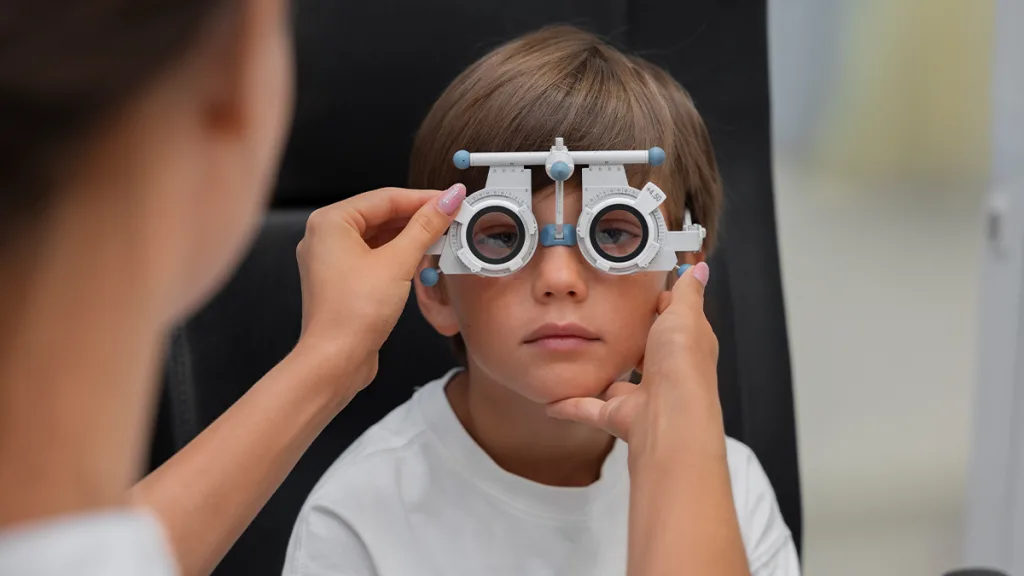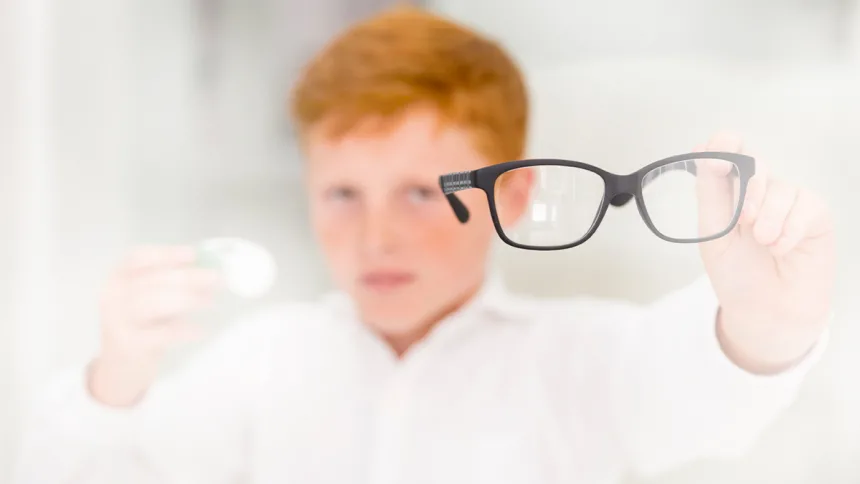While Parents enjoy staring at their baby’s eyes—Parents are not sure of how well their baby can see them. Increasing awareness of how vision develops in infants and young children is crucial for early detection of visual impairment. This article highlights the normal development of vision with visual milestone changes in toddlers and school-age children, signs of visual impairment, and the obstacles to proper eye care, along with solutions to improve children’s vision health.
Development of vision in early childhood
The first few months of life are essential for vision development in babies. As the baby grows, the vision changes quickly. It is crucial for parents and child care personnel as well as schoolteachers to pay careful attention to the development of vision in children to help catch problems early. To do that parents need to be aware and educated about the normal development of a baby’s vision.
Newborn-3 months: At birth, newborns can detect light and movement they blink in response to bright lights. Baby starts to focus on objects 8-15 inches away. They attach to high contrast-coloured objects, especially white, black, and red. By the first month, they begin holding eye contact and watch parents closely. If eyes are uncoordinated or look crossed-eyed; during this period, parents should contact an eye doctor.
4-5 months: Baby begins to reach hands to objects and bat at hanging objects between 4-5 months, they also can stare at blocks and recognize feeding bottles.
5-7 months: Baby develops full-colour vision, becomes able to see objects at longer distances, can turn their head to see or follow a moving object, like certain colours, and touch self-image in mirror. More care should be paid to avoid eye injury at this stage
7-11 months: The baby stares at small objects, develops depth perception and starts playing with peek-a-boo toys. At 11-12 months a baby is able to watch objects that are moving fast.
12-14 months: Baby can place shapes in proper holes, recognizes common objects and pictures in books, point to objects when asked, and recognize own face in a mirror.
18-24 months: The baby becomes able to focus on near and far objects, scribble with crayons, draw straight lines or circles and becomes able to point to body parts when asked.
3-4 years: They can copy shapes and name colors. At this age, an eye check-up is important because by this time their vision should be near 20/20.
4-6 years: Children identify and recite the alphabet, start reading, develop complete depth perception, use scissors and name coins and money. It is highly recommended to take the child to the eye doctor for complete eye checkup before starting school to exclude refractive errors and any misalignment.
Poor lighting conditions at home and school, prolonged long screen time and lack of outdoor activity worsen eye health in children.
Professor Mohamed Al-Shabrawey MD, Ph.D, Director, Eye Research Institute and Center, OUWB-School of Medicine, Oakland University, Rochester, MI, USA
—Dr. Muhammad Haque MD, Ph.D, Postdoctoral Fellow, Prof. Mohamad Al-Shabrawey’s Lab, Eye Research Institute, Oakland University
Common vision problems in children
Refractive errors and blurring of vision in children can easily be corrected with proper eyeglasses. Remember, if there is blurriness in child’s vision and eyeglasses are not prescribed as early as possible, amblyopia may develop. Amblyopia means reduced vision in one or both eyes, which is also termed lazy eye, due to abnormal visual development. Amblyopia generally develops from birth-7-year-old.
Strabismus occurs in about 4% of children. It is characterized by misalignment in which one eye looks straight ahead while the other eye turns in different direction (up, down, inward or outward). In strabismus, the child does not have the ability of focusing on an object simultaneously with both his/her eyes. Minor strabismus can be corrected with eyeglass, whereas major misalignments need surgical intervention.
Eye injuries are the most common cause of blindness among school age children. Pay attention when a child is playing with ball. Keep your child away from cleaning products and sharp objects to prevent eye injuries.
Digital eye strain: Nowadays one important topic is “use of smart device in children”. Use of smartphones or smart devices either by parents or by the child, at any developmental age, will negatively affect the child’s cognitive ability, social or emotional skills, and sleep pattern. So please keep your baby away from smart devices.
Retinopathy of Prematurity (ROP): A pregnant woman should always take care of any health problems, like diabetes, high blood pressure, or depression to avoid premature delivery which might lead to a condition called Retinopathy of Prematurity (ROP). Don’t smoke, drink, or use illegal drugs during pregnancy. Eat a diet that includes a variety of healthy foods and gain a healthy amount of weight (not too much or too little) during pregnancy. If there is a premature delivery, keep close contact with an eye/retina specialist to exclude ROP, because ROP leads to severe visual impairment or even blindness in newborn babies.
White pupillary reflex: If a baby is born with an eye condition, in that case, contact an eye specialist for further evaluation. A white pupillary reflex may be due to cataract, retinoblastoma, ROP, or retinal detachment due to many congenital retinal eye diseases.
Myopia epidemic: Shortsighted vision is increasing at an alarming rate across the world partly due to environmental factors like screen exposure. If neglected, high myopia increases can cause serious eye conditions like glaucoma and retinal detachment in adulthood.

Recognizing vision problems in children
The following represent the most important symptoms of childhood vision problems:
- Loss of interest in participating in vision-dependent activities
- Losing place during reading
- The child has to turn the head to see something in front.
Noticing one or more of these symptoms requires scheduling an eye exam for their child. For parents, there is nothing more precious than a happy child with proper vision.
Also Read : Investing In Longevity Boosts Productivity And Cuts Healthcare Costs
Why are we failing next generation’s eye health?
Unfortunately, child eye health is often neglected, leading to negative impact on the child’s life in general and academic development in particular as well as on the community at large. The key reasons for why we fail children’s eye health are:
- Lack of awareness: Parents and schoolteachers may not recognize early signs of vision problems in children delaying the seek for eye care.
- Limited access to eye care facilities: The shortage of pediatric ophthalmologists and optometrists, especially in low-income communities and rural areas, particularly, families may struggle with the cost of eye exams, glasses, or treatments.
- Lack of school screening programs: School-based vision screenings are crucial to maintain healthy vision in children. Unfortunately, this screening system is often inconsistent or nonexistent in many countries.
- Delayed diagnosis of vision problems: Eye problems like amblyopia (lazy eye), retinopathy of prematurity or congenital cataracts require early detection and immediate treatment. Without timely treatments, permanent vision loss may occur.
- Environmental factors and digital eye strain: Excessive screen time among children contributes to increased cases of myopia (nearsightedness). Poor lighting conditions at home and school as well as lack of outdoor activity worsen eye health.
- Funding and policy gaps: Pediatric ophthalmology research and clinical practice receive less attention and support than adult vision research and clinical care by governments and healthcare systems. This contributes to vision impairment in children.
Early detection and timely treatment of eye problems like amblyopia (lazy eye), retinopathy of prematurity or congenital cataracts are crucial for raising successful kids
Professor Mohamed Al-Shabrawey MD, Ph.D, Director, Eye Research Institute and Center, OUWB-School of Medicine, Oakland University, Rochester, MI, USA
—Dr. Muhammad Haque MD, Ph.D, Postdoctoral Fellow, Prof. Mohamad Al-Shabrawey’s Lab, Eye Research Institute, Oakland University
Solutions to improve child eye health
- Implementing mandatory vision screenings for all children before school entry and regular follow-ups and
- Improving access to eye care through free eye exams and glasses for children from low-income families.
- Enhancement of Parental and Teacher Awareness to recognizing early signs of vision problems can also contribute to improvement of children’s vision.
- Encouraging outdoor Play and Screen Time Management are also important to reduce the risk of myopia.
- Finally, strengthening health policies to support research, training, and resources for child eye health.
Addressing these issues early can ensure better academic performance, social development, and overall well-being for children while reducing the long-term burden on healthcare systems.
Children depend on their vision for learning, developing social interaction, and overall development. Early diagnosis and therapeutic interventions of vision problems can prevent and treat vision problems and subsequently improve the quality of life of our children. By supporting pediatric ophthalmology research and clinical service, every child will have the opportunity to grow, learn, and live with healthy vision.



















